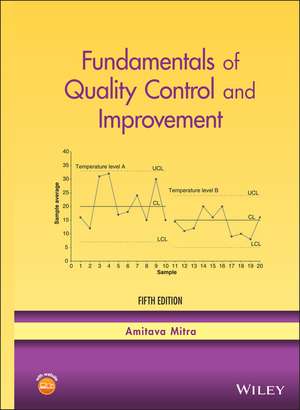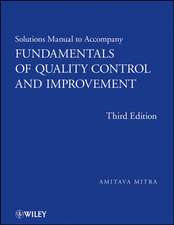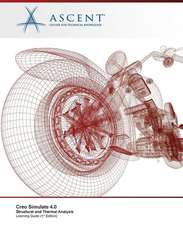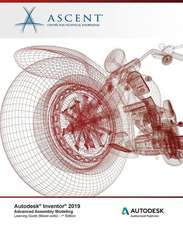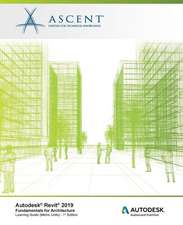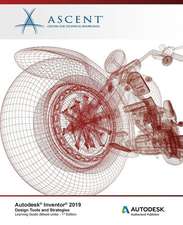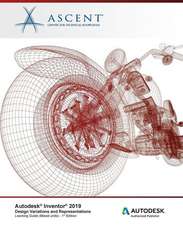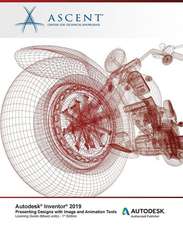Fundamentals of Quality Control and Improvement
Autor Amitava Mitraen Limba Engleză Hardback – 28 iun 2021
Preț: 930.48 lei
Preț vechi: 1022.50 lei
-9% Nou
Puncte Express: 1396
Preț estimativ în valută:
178.10€ • 193.53$ • 149.70£
178.10€ • 193.53$ • 149.70£
Carte tipărită la comandă
Livrare economică 21 aprilie-05 mai
Preluare comenzi: 021 569.72.76
Specificații
ISBN-13: 9781119692331
ISBN-10: 1119692334
Pagini: 800
Dimensiuni: 178 x 254 x 45 mm
Greutate: 1.58 kg
Ediția:5th Edition
Editura: Wiley
Locul publicării:Hoboken, United States
ISBN-10: 1119692334
Pagini: 800
Dimensiuni: 178 x 254 x 45 mm
Greutate: 1.58 kg
Ediția:5th Edition
Editura: Wiley
Locul publicării:Hoboken, United States
Cuprins
PREFACE xix
ABOUT THE COMPANION WEBSITE xxiii
PART I PHILOSOPHY AND FUNDAMENTALS 1
1 Introduction to Quality Control and the Total Quality System 3
1-1 Introduction and Chapter Objectives 3
1-2 Evolution of Quality Control 4
1-3 Quality 7
Quality Characteristics 8
Variables and Attributes 8
Defects 9
Standard or Specification 9
Quality of Design 10
Quality of Conformance 10
Quality of Performance 11
1-4 Quality Control 12
Off-Line Quality Control 12
Statistical Process Control 12
Acceptance Sampling Plans 13
1-5 Quality Assurance 13
1-6 Quality Circles and Quality Improvement Teams 14
1-7 Customer Needs and Market Share 15
Kano Model 15
1-8 Benefits of Quality Control and the Total Quality System 16
Total Quality System 17
1-9 Quality and Reliability 18
1-10 Quality Improvement 18
1-11 Product and Service Costing 19
Activity-Based Costing 20
1-12 Quality Costs 23
Prevention Costs 23
Appraisal Costs 23
Internal Failure Costs 24
External Failure Costs 24
Hidden Failure Costs 24
Quality Costs Data Requirements 24
Process Cost Approach 26
1-13 Measuring Quality Costs 27
Impact of Quality Improvement on Quality Costs 29
1-14 Management of Quality 31
1-15 Quality and Productivity 34
Effect on Cost 34
Effect on Market 34
1-16 Total Quality Environmental Management 37
Green Supply Chain 39
Summary 40
Key Terms 41
Exercises 41
References 46
2 Some Philosophies and Their Impact on Quality 47
2-1 Introduction and Chapter Objectives 47
2-2 Service Industries and Their Characteristics 47
Differences in the Manufacturing and Service Sectors 49
Service Quality Characteristics 50
Measuring Service Quality 52
Techniques for Evaluating Service Quality 52
2-3 Model for Service Quality 53
2-4 W. Edwards Deming's Philosophy 56
Extended Process 57
Deming's 14 Points for Management 58
Deming's Deadly Diseases 72
2-5 Philip B. Crosby's Philosophy 75
Four Absolutes of Quality Management 76
14-Step Plan for Quality Improvement 76
2-6 Joseph M. Juran's Philosophy 78
Quality Trilogy Process 79
Quality Planning 79
Quality Control 80
Quality Improvement 81
2-7 The Three Philosophies Compared 82
Definition of Quality 82
Management Commitment 82
Strategic Approach to a Quality System 83
Measurement of Quality 83
Never-Ending Process of Improvement 83
Education and Training 83
Eliminating the Causes of Problems 84
Goal Setting 84
Structural Plan 84
Summary 85
Key Terms 85
Exercises 86
References 88
3 Quality Management: Practices Tools and Standards 89
3-1 Introduction and Chapter Objectives 89
3-2 Management Practices 90
Total Quality Management 90
Vision and Quality Policy 92
Balanced Scorecard 94
Performance Standards 96
3-3 Quality Function Deployment 99
QFD Process 100
3-4 Benchmarking and Performance Evaluation 106
Benchmarking 107
Quality Auditing 110
Vendor Selection and Certification Programs 112
Vendor Rating and Selection 112
3-5 Health Care Analytics 115
Health Care Analytics and Big Data 116
Uniqueness of Health Care 116
Challenges in Health Care Quality 121
3-6 Tools for Continuous Quality Improvement 124
Pareto Diagrams 124
Flowcharts 124
Cause-and-Effect Diagrams 126
Scatterplots 126
Multivariable Charts 127
Matrix and Three-Dimensional Plots 129
Failure Mode and Effects Criticality Analysis 131
3-7 International Standards ISO 9000 and Other Derivatives 137
Features of ISO 9000 137
Other Industry Standards 138
Case Study 139
Summary 143
Key Terms 144
Exercises 145
References 149
PART II STATISTICAL FOUNDATIONS AND METHODS OF QUALITY IMPROVEMENT 151
4 Fundamentals of Statistical Concepts and Techniques in Quality Control and Improvement 153
4-1 Introduction and Chapter Objectives 154
4-2 Population and Sample 154
4-3 Parameter and Statistic 154
4-4 Probability 155
Relative Frequency Definition of Probability 155
Simple and Compound Events 155
Complementary Events 156
Additive Law 157
Multiplicative Law 158
Independence and Mutually Exclusive Events 158
4-5 Descriptive Statistics: Describing Product or Process Characteristics 160
Data Collection 160
Measurement Scales 162
Measures of Central Tendency 163
Measures of Dispersion 165
Measures of Skewness and Kurtosis 170
Measures of Association 173
4-6 Probability Distributions 177
Cumulative Distribution Function 179
Expected Value 179
Discrete Distributions 180
Continuous Distributions 184
4-7 Inferential Statistics: Drawing Conclusions on Product and Process Quality 193
Sampling Distributions 193
Estimation of Product and Process Parameters 194
Hypothesis Testing 203
Summary 216
Appendix: Approximations to Some Probability Distributions 216
Binomial Approximation to the Hypergeometric 216
Poisson Approximation to the Binomial 216
Normal Approximation to the Binomial 217
Normal Approximation to the Poisson 218
Key Terms 219
Exercises 220
References 232
5 Data Analyses and Sampling 233
5-1 Introduction and Chapter Objectives 233
5-2 Empirical Distribution Plots 234
Histograms 234
Stem-and-Leaf Plots 235
Box Plots 236
Variations of the Basic Box Plot 238
5-3 Randomness of a Sequence 239
Run Chart 239
5-4 Validating Distributional Assumptions 241
Probability Plotting 241
5-5 Transformations to Achieve Normality 244
Some Common Transformations 244
Power Transformations 244
Johnson Transformation 245
5-6 Analysis of Count Data 248
Hypothesis Test on Cell Probabilities 248
Contingency Tables 249
Measures of Association 251
5-7 Analysis of Customer Satisfaction Data 252
Customer Needs and Their Level of Satisfaction 252
Displaying Survey Results 257
Analysis of Survey Results 259
5-8 Concepts in Sampling 261
Sampling Designs and Schemes 262
Sample Size Determination 264
Bound on the Error of Estimation and Associated Confidence Level 264
Estimating the Difference of Two Population Means 266
Estimating the Difference of Two Population Proportions 266
Controlling the Type I Error Type II Error and Associated Parameter Shift 267
5-9 Bayes Rule and Decision Making Based on Samples 268
5-10 Deming's kp rule 272
Summary 274
Key Terms 275
Exercises 276
References 283
PART III STATISTICAL PROCESS CONTROL 285
6 Statistical Process Control Using Control Charts 287
6-1 Introduction and Chapter Objectives 287
6-2 Causes of Variation 289
Special Causes 289
Common Causes 289
6-3 Statistical Basis for Control Charts 289
Basic Principles 289
Selection of Control Limits 291
Errors in Making Inferences from Control Charts 293
Effect of Control Limits on Errors in Inference Making 297
Warning Limits 298
Effect of Sample Size on Control Limits 298
Average Run Length 299
6-4 Selection of Rational Samples 301
Sample Size 301
Frequency of Sampling 301
6-5 Analysis of Patterns in Control Charts 302
Some Rules for Identifying an Out-of-Control Process 302
Interpretation of Plots 304
Determination of Causes of Out-of-Control Points 306
6-6 Maintenance of Control Charts 306
Summary 307
Key Terms 307
Exercises 307
References 310
7 Control Charts for Variables 311
7-1 Introduction and Chapter Objectives 312
7-2 Selection of Characteristics for Investigation 313
7-3 Preliminary Decisions 314
Selection of Rational Samples 314
Sample Size 315
Frequency of Sampling 315
Choice of Measuring Instruments 315
Design of Data Recording Forms 315
7-4 Control Charts for the Mean and Range 315
Development of the Charts 315
Variable Sample Size 321
Standardized Control Charts 321
Control Limits for a Given Target or Standard 322
Interpretation and Inferences from the Charts 325
Control Chart Patterns and Corrective Actions 327
7-5 Control Charts for the Mean and Standard Deviation 333
No Given Standards 334
Given Standard 335
7-6 Control Charts for Individual Units 338
No Given Standards 339
Given Standard 340
7-7 Control Charts for Short Production Runs 342
_X- and R-Charts for Short Production Runs 342
Z-MR Chart 342
7-8 Other Control Charts 344
Cumulative Sum Control Chart for the Process Mean 344
Tabular Method 345
V-Mask Method 348
Cumulative Sum for Monitoring Process Variability 351
Moving-Average Control Chart 351
Exponentially Weighted Moving-Average or Geometric Moving-Average Control Chart 354
Modified Control Chart 357
Acceptance Control Chart 361
7-9 Risk-Adjusted Control Charts 363
Risk-Adjusted Cumulative Sum (RACUSUM) Chart 364
Risk-Adjusted Sequential Probability Ratio Test (RASPRT) 365
Risk-Adjusted Exponentially Weighted Moving-Average (RAEWMA) Chart 366
Variable Life-Adjusted Display (VLAD) Chart 367
7-10 Multivariate Control Charts 370
Controlling Several Related Quality Characteristics 370
Hotelling's T2 Control Chart and Its Variations 373
Phase 1 and Phase 2 Charts 374
Usage and Interpretations 376
Individual Observations with Unknown Process Parameters 377
Generalized Variance Chart 378
Case Study 384
Summary 388
Key Terms 389
Exercises 390
References 403
8 Control Charts for Attributes 405
8-1 Introduction and Chapter Objectives 406
8-2 Advantages and Disadvantages of Attribute Charts 406
Advantages 406
Disadvantages 407
8-3 Preliminary Decisions 408
8-4 Chart for Proportion Nonconforming: p-Chart 408
Construction and Interpretation 409
Variable Sample Size 416
Risk-Adjusted p-Charts in Health Care 420
Special Considerations for p-Charts 424
8-5 Chart for Number of Nonconforming Items: np-Chart 425
No Standard Given 425
Standard Given 426
8-6 Chart for Number of Nonconformities: c-Chart 427
No Standard Given 428
Standard Given 428
Probability Limits 430
Applications in Health Care When Nonoccurence of Nonconformities Are Not Observable 431
8-7 Chart for Number of Nonconformities Per Unit: u-Chart 433
Variable Sample Size and No Specified Standard 433
Risk-Adjusted u-Charts in Health Care 436
8-8 Chart for Demerits Per Unit: u-Chart 439
Classification of Nonconformities 439
Construction of a U-Chart 439
8-9 Charts for Highly Conforming Processes 442
Transformation to Normality 442
Use of Exponential Distribution for Continuous Variables 442
Use of Geometric Distribution for Discrete Variables 443
Probability Limits 443
Applications in Health Care of Low-Occurrence Nonconformities 445
8-10 Operating Characteristic Curves for Attribute Control Charts 447
Case Study 450
Summary 455
Key Terms 455
Exercises 456
References 469
9 Process Capability Analysis 471
9-1 Introduction and Chapter Objectives 471
9-2 Specification Limits and Control Limits 472
9-3 Process Capability Analysis 473
Process Capability 474
9-4 Natural Tolerance Limits 475
Statistical Tolerance Limits 476
9-5 Specifications and Process Capability 476
9-6 Process Capability Indices 479
Cp Index 479
Upper and Lower Capability Indices 480
Cpk Index 481
Capability Ratio 483
Taguchi Capability Index Cpm 484
Cpmk Index 484
Confidence Intervals and Hypothesis Testing on Capability Indices 485
Comparison of Capability Indices 486
Effect of Measurement Error on Capability Indices 490
Gage Repeatability and Reproducibility 492
Evaluation of Measurement Systems 493
Metrics for Evaluation of Measurement Systems 493
Preparation for a Gage Repeatability and Reproducibility Study 494
Cp Index and the Nonconformance Rate 497
9-7 Process Capability Analysis Procedures 498
Estimating Process Mean and Standard Deviation 498
9-8 Capability Analysis for Nonnormal Distributions 500
Identification of Appropriate Distribution 500
Box-Cox Transformation 500
Using Attribute Charts 500
Using a Nonparametric Approach 501
9-9 Setting Tolerances on Assemblies and Components 502
Tolerances on Assemblies and Subassemblies 502
Tolerance Limits on Individual Components 504
Tolerance on Mating Parts 505
Nonlinear Combinations of Random Variables 508
9-10 Estimating Statistical Tolerance Limits of a Process 509
Statistical Tolerance Limits Based on Normal Distribution 509
Nonparametric Statistical Tolerance Limits 510
Case Study 511
Summary 515
Key Terms 516
Exercises 516
References 525
PART IV PRODUCT AND PROCESS DESIGN 527
10 Reliability 529
10-1 Introduction and Chapter Objectives 529
10-2 Reliability 530
10-3 Life-Cycle Curve and Probability Distributions in Modeling Reliability 530
Probability Distributions to Model Failure Rate 531
Availability 534
10-4 System Reliability 534
Systems with Components in Series 535
Systems with Components in Parallel 537
Systems with Components in Series and in Parallel 539
Systems with Standby Components 540
10-5 Operating Characteristic Curves 542
10-6 Reliability and Life Testing Plans 544
Types of Tests 544
Life Testing Plans Using the Exponential Distribution 546
Standard Life Testing Plans Using Handbook H-108 548
10-7 Survival Analysis 552
Estimation of the Survival Function 552
Confidence Intervals for the Survival Function 557
Comparion of Survival Functions of Two Groups 559
Summary 563
Key Terms 563
Exercises 564
References 567
11 Experimental Design and the Taguchi Method 569
11-1 Introduction and Chapter Objectives 570
11-2 Experimental Design Fundamentals 570
Features of Experimentation 574
11-3 Some Experimental Designs 575
Completely Randomized Design 576
Randomized Block Design 582
Latin Square Design 587
11-4 Factorial Experiments 595
Two-Factor Factorial Experiment Using a Completely Randomized Design 596
Two-Factor Factorial Experiment Using a Randomized Block Design 600
Role of Contrasts 606
The 2k Factorial Experiment 612
Confounding in 2k Factorial Experiments 616
Fractional Replication in 2k Experiments 617
11-5 The Taguchi Method 623
11-6 The Taguchi Philosophy 624
11-7 Loss Functions 627
Target Is Best 628
Smaller Is Better 631
Larger Is Better 632
11-8 Signal-to-Noise Ratio and Performance Measures 634
Target Is Best 634
Smaller Is Better 637
Larger Is Better 637
11-9 Critique of S/N Ratios 637
11-10 Experimental Design in the Taguchi Method 638
Orthogonal Arrays and Linear Graphs 639
Estimation of Effects 649
11-11 Parameter Design in the Taguchi Method 654
Application to Attribute Data 656
11-12 Critique of Experimental Design and the Taguchi Method 658
Summary 660
Key Terms 661
Exercises 662
References 672
12 Process Modeling Through Regression Analysis 675
12-1 Introduction and Chapter Objectives 675
12-2 Deterministic and Probabilistic Models 676
12-3 Model Assumptions 678
12-4 Least Squares Method for Parameter Estimation 680
Performance Measures of a Regression Model 683
12-5 Model Validation and Remedial Measures 686
Linearity of Regression Function 686
Constancy of Error Variance 687
Normality of Error Component 689
Independence of Error Components 689
12-6 Estimation and Inferences from a Regression Model 690
Inferences on Individual ßi Parameters 691
Inferences on All ßi i= 1 2 . . . p . 1 Parameters 691
Simultaneous Inferences on Some ßi i= 1 2 . . . p . 1 691
Hypothesis Tests on a Subset of ßi Parameters 692
Estimation of Mean Response 692
Simultaneous Confidence Intervals for Several Mean Responses 693
Prediction of Individual Observations 693
Simultaneous Prediction Intervals for Several New Observations 693
12-7 Qualitative Independent Variables 696
Additive Model 696
Interaction Model 697
12-8 Issues in Multiple Regression 702
Data from a Retrospective Versus Designed Experiment 702
Outliers in the Space of the Independent Variables 703
Outliers for the Dependent Variable 704
Influential Observations 705
Multicollinearity 706
Detection of Multicollinearity 706
Effects of Multicollinearity 707
12-9 Logistic Regression 707
Binary Response Variable 708
Assumptions in Regression 709
Nominal Polytomous Response Variable 712
Ordinal Polytomous Response Variable 715
12-10 Classification Problems 719
Performance Measures in Classification Problems 720
Tests of Association in 2 × 2 Contingency Tables 722
Receiver Operating Characteristic Curve 723
Summary 725
Key Terms 725
Exercises 726
References 732
Appendixes 733
A-1 Cumulative Binomial Distribution 733
A-2 Cumulative Poisson Distribution 738
A-3 Cumulative Standard Normal Distribution 740
A-4 Values of t for a Specified Right-Tail Area 743
A-5 Chi-Squared Values for a Specified Right-Tail Area 745
A-6 Values of F for a Specified Right-Tail Area 747
A-7 Factors for Computing Centerline and Three-Sigma Control Limits 753
A-8 Uniform Random Numbers 754
Index 000
